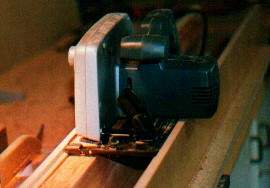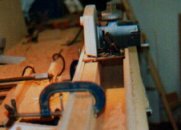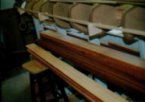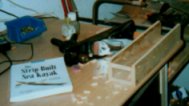|
I have a hand-held electric saw ( a Black and Decker ProLine P40 with a 7 1/4" ripping blade with a 1/8" kerf ). It easily cuts through 2" of cedar. My plan was to use it to rip a 2" deep cut down one side of the log, then reverse the log and rip again from the opposite side. Hopefully, the two cuts would meet and a nice clean slice would fall off ! I tried using the saw fence ( with a long strip of wood attached to it ) but it was difficult to hold the saw steady so this produced a very wobbly cut. So I tried another approach with a U-shaped jig. I cut a piece of MDF seven foot long and approx 12 " wide. I attached two uprights along this base ( approx 7" apart ) with rebates along their inside top into which my hand-held saw fitted snugly. The blade of the saw was 3/4" from the inside edge of one of the uprights. The log was placed in between the uprights, clamped in place with wedges and I ran the saw along the rebates in the MDF. Then I turned the log over and repeated the cut. This was not 100% successful. Although the
log faces were fairly smooth they were not
exactly parallel so the cuts did not meet perfectly.
However, as I was planning on cutting the
new pieces down the middle, this would
remove the slight step ! I then ripped
the pieces into strips on the table saw. |




